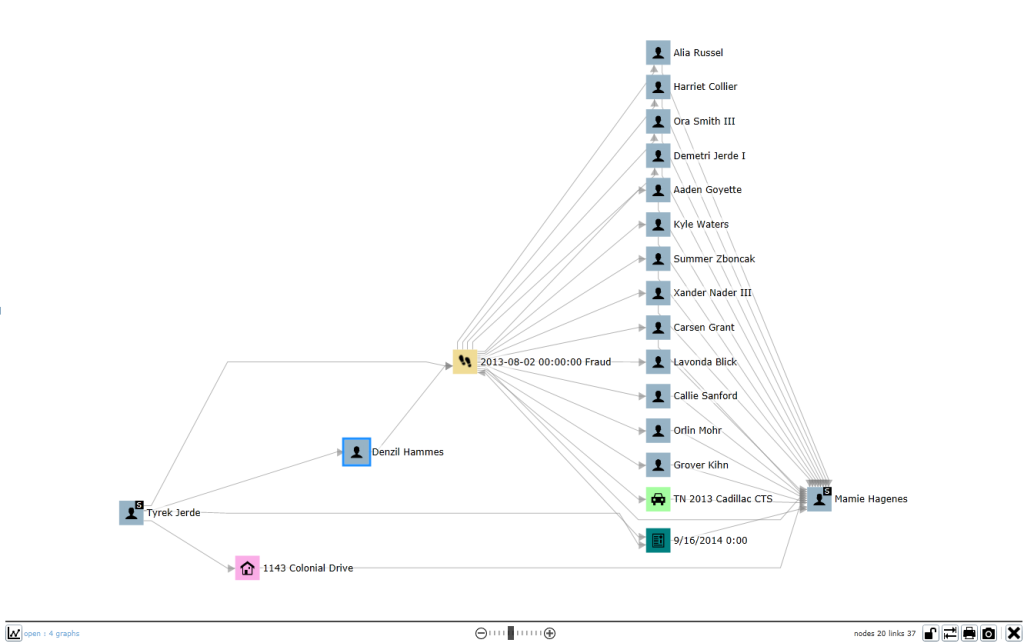
Analytics Set to Take Down ‘Felony Lane’ Gang

A notorious criminal organization known as the Felony Lane Gang has been perpetrating its brand of thievery largely unnoticed for the past decade. While each individual crime is relatively small–$500 here, $1,400 there—collectively it adds up to tens of millions of dollars. But now, a group of law enforcement organizations is looking to put the group out of business using the power of advanced analytics.
The Felony Lane Gang has its roots in South Florida, where a group of small-time hoodlums hit upon a winning recipe for conducting crime that generally falls under the radar of local law enforcement. People familiar with the gang’s methods say they nearly always follow the recipe to a T:
- Step one: Break into a car in a busy area, such as shopping mall or a gym.
- Step two: Steal any or checks or identity cards that can be used for fraud.
- Step three: Recruit prostitutes or homeless people to cash the stolen checks.
- Step four: Dress the recruit up to look like the victim, including using wigs.
- Step five: Go to the victim’s bank, and pick the drive-thru that’s the farthest away from the human teller (i.e. the “felony lane”) to cash checks written in relatively small amounts that won’t be flagged by law enforcement.
- Step six: Repeat.
Because of the small-time nature of the crimes, they did get the attention of law enforcement agencies. But a few years back, some police departments and sheriff’s organizations detected a pattern to the crimes, at which point they named the group the Felony Lane Gang (it’s unclear what the group calls itself).
Detecting Criminal Signals
Identifying the crimes in hindsight was hard enough, considering the millions of small crimes and petty thefts that occur each year across the country. But getting in front of this problem would prove to be an even bigger challenge, especially considering that this particular criminal enterprise has spread to 34 states and is known to involve more than 100 ringleaders, all of whom hail from the Fort Lauderdale area.
That’s why a group of law enforcement organizations led by Marion County Sheriff’s Office last month formed the Felony Lane Gang Working Group, which is composed of 92 organizations, including state, city and county law enforcement agencies, the FBI, the Secret Service, and financial institutions. Also working with the task force are Wynyard Group, a provider of advanced crime analytics software, and CI Technologies, which develops the popular CrimeNtel database used by 110 public safety agencies.
Getting big data analytics will be critical to taking down the Felony Lane Gang, says Louis Quijas, a former assistant secretary to the US Department of Homeland Security and a consultant to Wynyard.
“With our advanced crime analytics tool, they will be able to get a better sense what the scope of the problem is, to be very proactive in not only addressing the crimes occurring daily, but also looking at how they can prevent crimes by sharing knowledge, rather than just intel, among themselves to create an overall strategy,” Quijas tells Datanami. “Even though each jurisdiction is handling things it in a little different way, collectively they’re coming up with an overarching strategy to address this criminal behavior.”
It’s all about sharing data and collaborating on a cause. Because of the nature of the Felony Lane Gang’s crimes and the fact that they steal small sums, it can be difficult to differentiate one crime from another. But because each agency is now sharing all of the data they gather–from arrest records to field interviews to license plates—they have a much better chance of detecting the gang’s criminal signature.
Piecing the Puzzle Together
Wynyard is being counted on to bring together all the individual data points associated with the Felony Lane Gang, and show the law enforcement agencies how they relate through its analytics framework.
As Wynyard’s Matt Melton sees it, it’s about stepping back to see the big picture. “You had these small pieces of fraud happening all over the country. The gang would hit three or four cars, steal no more than $900 at once, so you’re looking at few grand,” he says. “From a local law enforcement perspective, it’s a couple thousand dollars. It’s not a lot when the insurance company will cover everything.”
But when you take a step back and can see the overall trend, it becomes clear that it’s a lot more than a couple thousands dollar. “You see there is a $100 million flowing out. Now you’re looking at not only small fraud but money laundering, human trafficking, and drugs. It becomes a lot more complex of a problem set, and without a way to share this data and collaborate on the information, there’s no way to actually see that.
Wynyard’s tools allow users to mine data that exists across all of the 92 agency’s databases, which are gathered in the centralized CrimeNtel database. “Now using advanced crime analytics, we all of a sudden see the broader network, we see the bigger picture. We see that this guy was caught in India polis as part of this ring, but also he got caught in Virginia for doing the same thing but they had to let him go because they weren’t able to put a case together.
It’s a Facebook-like social graph, but for smalltime thugs and criminals. “These guys have known associates, so all of a sudden we’re seeing a big expansive network of social network of people,” Melton says. “If I was doing this manually back in old days, I’d have a massive whiteboard I’m going through and drawing all these connections. [With analytics software] I’m actually able to search and find those connection that I wasn’t able to see before.”

Louis Quijas, a former assistant secretary to the US Department of Homeland Security and a consultant to Wynyard.
Wynyard’s tools also provide the entity extraction capabilities (finding people, places, and things) that make investigators jobs much easier. “The key to that is there’s massive amounts of information, so I need a computer to help me narrow down what’s important,” Melton says. “So by using social network analysis algorithms and some of our other tools availed, we can actually find those and turn it from data to information to knowledge.”
Law Enforcement’s Growing Reliance on Analytics
Before 9/11, law enforcement would have taken a brute-force approach to solving this kind of problem, but now, by necessity, it must be handled with just a few investigators. That’s why having the right set of data and tools is so important.
“When I was a police chief, I used to throw people at problems. I used to be able to send out detectives and do canvas of the area and do field interviews,” says Quijas, who has been a lawman for nearly 40 years. “But in today’s environment, with the major staff shortage across the board… you really need to dig down deeper. The [criminals] may be knuckleheads, but they’re not dumb. They’re very smart. So you need all the tools that you can get.”
In the post-9/11 world, advanced analytics gives law enforcement an edge over the criminals trying to avoid detection. “If you have the crime analytics and you’re able to connect people to a crime and people to people, it gets you a clear picture and allows you to pinpoint where you need to deploy your resources,” Quijas says. “So crime analytics is playing a major role in law enforcement at the federal, state, and local level.”
The Felony Lane Gang is still in business. It’s keeping a low profile and continues to perpetrate its particular brand of low-level fraud in cities across the country. But thanks to big data analytics, it’s lost its cloak of invisibility, and soon it could even be the subject of a federal law enforcement task force.
Related Items:
Police Push the Limits of Big Data Technology
How Big Data Analytics Can Help Fight ISIS
How LifeLock Uses Big Data to Fight Identity Fraud
































